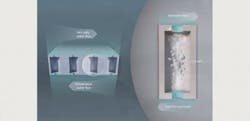Insects inspire greener, cheaper membranes for desalination
Source: King Abdullah University Of Science & Technology (KAUST)
SAUDI ARABIA, JULY 16, 2019 -- A new membrane made from water-wet materials has specially designed gas-entrapping pores that allow it to simultaneously separate hot, salty from cool, pure water while facilitating the transfer of pure vapor from one side to the other. This principle, designed by KAUST researchers, could lead to greener, cheaper desalination membranes.
Currently, super-water-repellent perfluorocarbon membranes are popularly used for a desalination process known as membrane distillation (MD). But perfluorocarbons are expensive, nonbiodegradable and vulnerable to fouling and damage at higher temperatures, explains KAUST postdoctoral fellow Ratul Das.
With the aim of developing perfluorocarbon-free alternatives, Himanshu Mishra and his team of researchers at KAUST's Water Desalination and Reuse Center drew inspiration from two insects: springtails that live in wet soils and seaskaters that live in open oceans. Both have mushroom-shaped microtextures covering their cuticles and hairs that can spontaneously entrap life-sustaining air if the insects become submerged in water. "We mimicked those features onto water-wet (nonwater resistant) materials. The resulting surfaces robustly entrap air upon immersion in liquids. The idea of gas-entrapping membranes was born," says Mishra.
Mishra's team developed protocols for creating vertical pores within thin sheets. The diameters of the pore inlets and exits were abruptly smaller than the pore channels. "We began by toying with thin wafers of silicon to develop pores with these reentrant edges," says Mishra. "These edges prevent liquids from intruding into the pores," he explains. "We were able to achieve the function of perfluorinated membranes by harnessing this bio-inspired texture using water-wet materials, which might seem to defy conventional wisdom." When a silicon membrane with simple cylindrical pores is immersed in water, it is completely filled within 1 second. Silica gas-entrapping membranes (GEMs), on the other hand, trap air robustly within their pores when immersed in water, and can remain intact for more than six weeks.
The team then explored applying the same principle to a cheaper, easily manufactured water-wet material called poly(methyl methacrylate) (PMMA), explains Sankara Arunachalam, a research technician in Mishra's team. "PMMA-GEMs robustly separated streams of hot, salty feed from cold water for more than 90 hours with a salt rejection of 100 percent," he says.
"To our knowledge, this is the first-ever demonstration of MD membranes derived from intrinsically wetting materials," says Mishra. "The benefits are obvious: common water-wet plastics, such as PMMA, are significantly cheaper than perfluorinated ones, are environmentally friendly, and can withstand harsher operational conditions. Interdisciplinary investigations are needed to assess the scalability and reliability of this approach."
The findings could unlock the potential of common water-wet materials for greener, cheaper desalination.
